Contents
Momordika surprises with her appearance. This exotic climbing plant belongs to the Pumpkin family and produces unusual fruits. It’s hard to tell if it’s a vegetable or a fruit. The fruit itself looks like a vegetable, and inside it are seeds in a shell, which are called berries. Momordica grows in Australia, Africa, India, Asia, Japan, it is also in the Crimea. They call it differently:
- bitter gourd
- indian pomegranate
- squirting cucumber
- chinese melon
- yellow cucumber
- cucumber crocodile
- balsamic pear
- mad melon
Momordica stems are thin and curly, like a liana, can grow up to 2 meters in height, the leaves are beautiful, cut, light green. The plant blooms with heterosexual yellow flowers, female ones are smaller with short pedicels. Flowering begins with male flowers and smells like jasmine. There are hairs on the stems that sting like nettles and remain until the fruit is fully ripe, after which they fall off.
Fruits with pimpled skin, similar to crocodile, grow up to 10-25 cm in length and up to 6 cm in diameter. During growth and maturation, they change their color from green to orange. Inside the fruit, up to 30 large seeds, with a dense ruby-colored shell, taste like a persimmon. When momordica is ripe, it opens into three fleshy petals and seeds fall out. Fully ripe fruits have a bitter taste and are often harvested unripe when they are almost yellow in color. Momordica matures in a bright cool room.
The calorie content of bitter melon per 100 g is only 19 kcal.
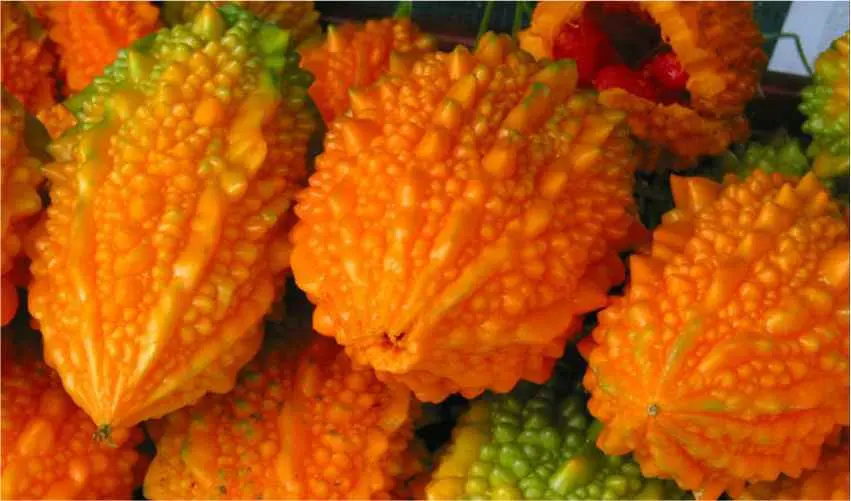
Due to the presence of very valuable biologically active compounds with powerful biological effects, this plant is used in folk medicine all over the world to treat various severe pathologies, mainly diabetes, as well as cancer and other diseases associated with inflammatory processes and metabolic disorders. This plant occupies one of the main positions in oriental medicine, and its components are included in many medicines certified around the world. Modern medicine confirms that the plant has antifungal, antibacterial, antiparasitic, antiviral, antifertile, antitumor, hypoglycemic and anticarcinogenic properties.
Momordica is the world’s most used herb for alternative antidiabetic medicines, as the plant contains an insulin-like compound called polypeptide-p or p-insulin, which naturally controls blood sugar levels.
Along with the traditional forms of taking dietary supplements (capsules, tablets and pills), the benefits of bitter melon are that its beneficial properties are perfectly preserved in drinks. Other fruits and vegetables are added to Momordica juice to improve the taste. Bitter gourd tea is a very popular medicinal drink in Japan and some other Asian countries.
Varieties and types
There are about 20 varieties of Momordica, which differ in taste and fruit size. The most popular varieties are:
- guarantee – the plant gives a good harvest of up to 50 fruits per bush. They are oval fusiform, grow up to 15 cm in length and are covered on top with papillary projections. Fully ripe, bright orange fruit;
- balsamic – one of the most medicinal varieties, with small fruits of bright orange color;
- large-fruited – round and large orange fruits;
- long-fruited – fruits with a large number of tubercles on the peel, grow up to 20 cm in length;
- Taiwan White – white fruits, which, when ripe, are absolutely not bitter, but the yield of the variety is low;
- Japan Long – fruits with a rich taste, very similar to persimmons, the weight of one such fruit reaches 400 g. The plant has a high yield;
- Orange Peke is a very sweet fruit of a bright orange color with few bumps on the skin.
- The nutritional value
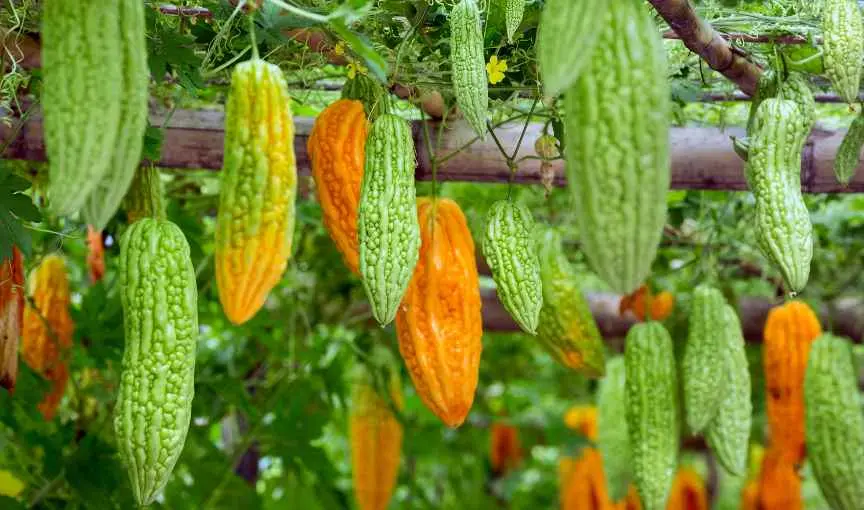
There are very few calories in 100 g of the fruit, only 15. Momordica is rich in vitamins C, A, E, B, PP, F, contains trace elements and substances important for the human body:
- dietary fiber – 2 g
- carbohydrates – 4.32 g
- proteins – 0.84 g
- lutein – 1323 mcg
- beta-carotene – 68 mcg
- ascorbic acid – 33 mg
- folic acid – 51 mg
- iron – 0.38 mg
- calcium – 9 mg
- potassium – 319 mcg
- phosphorus – 36 mg
- zinc – 0.77 mg
- magnesium – 16 mg
Useful properties and harm
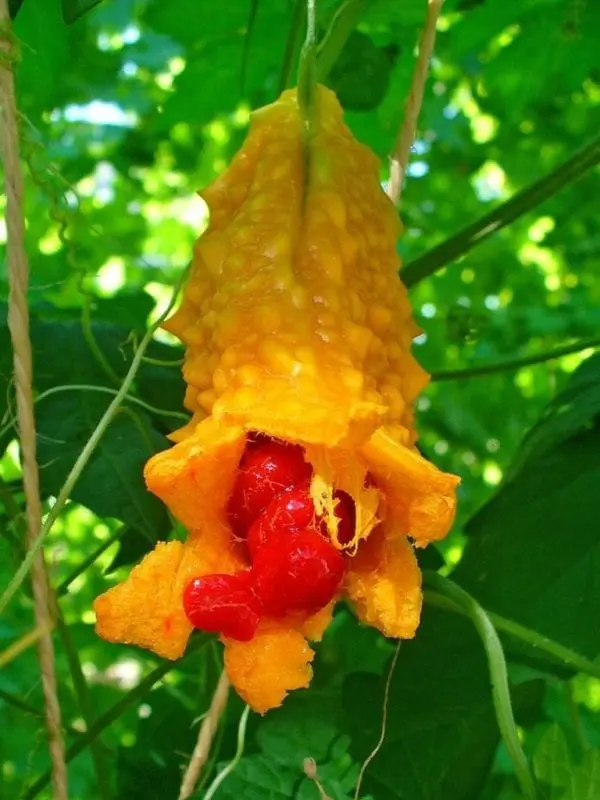
Momordica is an extremely healthy fruit that strengthens the immune system and vision, removes toxins and toxins from the body. The seed shell contains a fatty oil rich in carotene; in the human body, this substance is converted into vitamin A. The seeds contain the bitter glycoside momordicin and substances that lower blood sugar levels, lycopene is a good antioxidant, and serves as a good prevention of cardiovascular diseases. When losing weight, the fruits are very effective and help accelerate metabolism.
In the roots of Momordica there are substances used in the treatment of rheumatism – triterpene saponins. Modern research shows that some types of compounds contained in the fruit can be used in the treatment of hepatitis and HIV, due to antiviral and antibacterial activity. American scientists have found that substances in Momordica juice not only stop the growth of cancer cells, but also destroy them.
It is not recommended to eat fruits and seeds in some cases:
- the period of pregnancy and lactation, substances that Momordica contains can lead to premature birth and colic in the newborn;
- an allergic reaction of the body;
- diseases of the stomach and intestines during an exacerbation;
- diseases of the thyroid gland.
- The seeds of the fruit should be eaten in a certain amount to avoid poisoning. For the first time when you meet momordica, try a small piece of the fruit, if there are no signs of food intolerance, you can eat it with pleasure.
Application in medicine
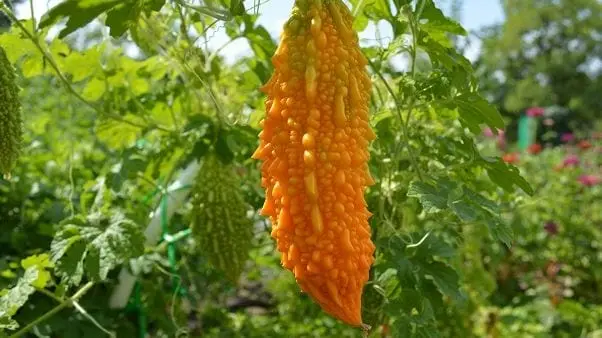
Momordica extract is successfully used to treat sarcoma, melanomas and leukemia, bones help relieve puffiness, are used for fever and inflammatory processes in the body. In the initial stages of gastrointestinal diseases, Momordica decoctions perform the function of antibiotics. Since ancient times, medicinal decoctions and tinctures have been prepared from the components of the plant.
Momordica, its seeds, roots and leaves help with various diseases:
- anemia
- high blood pressure
- cold
- cough
- liver disease
- burns
- acne
- psoriasis
- furunculosis
- Extracts from the plant are used in cosmetology, the products smooth out wrinkles and increase skin elasticity.
Tincture of fruits for colds
Cut the momordica into small pieces, remove the seeds. Place the fruits tightly in a 3-liter jar and pour 500 ml of vodka. Close the container with a lid and leave in a dark place for 2 weeks.
The tincture is taken 3 times a day, 1 teaspoon before meals. An effective remedy for influenza, colds and for strengthening the immune system.
Seed decoction
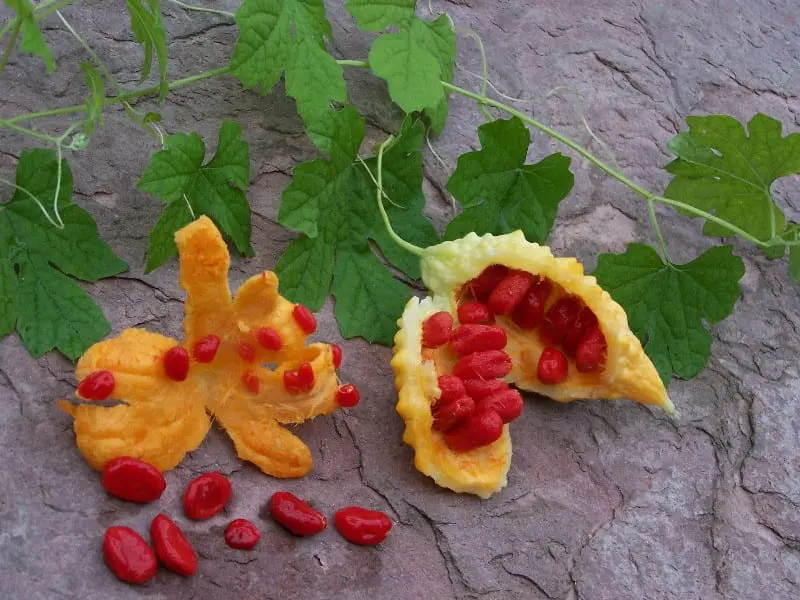
Place 20 seeds in an enamel container and pour a glass of boiling water. Keep on fire for 10 minutes, remove from the stove and leave to brew for 1 hour, drain.
Take 3-4 times a day, 50 ml in a febrile state.
Cooking applications
In Asia, momordica is used in traditional cuisine. Soups, snacks and salads are prepared from fruits, shoots and young leaves. Fruits are eaten in ripe and slightly unripe form. Delicious fried and pickled momordica. The fruits are added to meat and vegetable dishes, as well as canned food for piquancy. Momordica is one of the main ingredients of the national Indian curry. Delicious jams, wine, liqueurs and liqueurs are prepared from the fruits. The seeds are added to confectionery, they have an unusual nutty-tropical taste.
Momordica salad
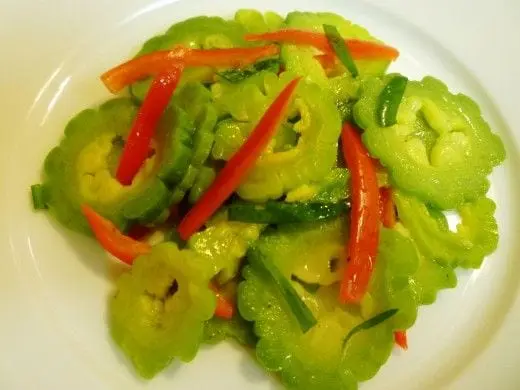
Ingredients:
- ripe fruit of momordica balsamic
- 15 g beet tops
- one tomato
- bulb
- half chili
- two tbsp. l. vegetable oil
- Sol
- a few young momordica leaves
- Preparation:
Soak the seedless momordica in salt water for 30 minutes to remove the bitterness.
Cut the onion into half rings, pepper into rings, squeeze the momordica lightly from the water and cut into slices.
Fry the onion in oil and season with salt, add momordica and pepper. Fry until all ingredients are done.
Chop the beet leaves and place on a plate, top with the tomato sliced in medium pieces.
Season the ingredients lightly on a plate and top the sauteed vegetables. Pour the remaining oil over the salad, garnish with young momordica leaves.
Growing at home
Increasingly, people take up growing momordica at home, thanks to its tasty and healthy fruits, many like it as an ornamental plant.
Growing from seeds always gives 100% result, in contrast to cuttings, and consists of several stages:
- choose seeds of a dark color, light ones are considered immature and are not suitable for planting;
- place the seeds at room temperature for 30 minutes in a weak solution of potassium permanganate;
- dilute 1 teaspoon of natural honey in a glass of warm water, soak a cloth napkin in this liquid and wrap the seeds in it. Put the seeds for 2 weeks to germinate in a warm place, you can near the battery. Moisten the napkin as it dries;
- take a few peat cups and fill with a mixture of humus and garden soil in a ratio of 3 to 1;
- heat the prepared soil substrate in the oven for 1 hour to remove possible spores and pest larvae;
- press sprouted seeds into the soil with an edge to a depth of 2 cm, sprinkle with calcined sand and water;
- place glasses in clear bags or cover with plastic bottles cut in the middle. This will provide the required moisture level. Maintain a room temperature of 20 degrees. Shoots should appear in 2 weeks;
- when sprouts appear, remove the cover and moisten the soil using a spray bottle. Place the plant in a bright spot. A window sill located on the west or east side is well suited. The sprouts should not be in direct sunlight;
- when the first leaves appear, feed the sprouts with a weak solution of potassium sulfate and superphosphate, the temperature in the room should be 16-18 degrees. On cloudy days, provide the plant with light and protect from drafts;
- 2 weeks after the first fertilization, add organic fertilizing to the soil, and after another 2 weeks – mineral fertilization. Water the plant regularly but in moderation, the soil should not dry out. Take to the open air for hardening on warm days;
- when the sprout grows 25 cm, transplant it into a larger pot or greenhouse, if there is no threat of frost. Planting is carried out directly in the cups, since the momordica root system does not tolerate transplantation.
- If you leave Mormodica to grow indoors, pollinate it. Use the brush to first brush over the male flowers and then over the female flowers, transferring pollen.









